|
|
 |
Fiche d'espèce de Copépode |
|
|
Calanoida ( Ordre ) |
|
|
|
Clausocalanoidea ( Superfamille ) |
|
|
|
Aetideidae ( Famille ) |
|
|
|
Chiridius ( Genre ) |
|
|
| |
Chiridius pacificus Brodsky, 1950 (F,M) | |
| | | | | | | Syn.: | Chiridius carnosus Tanaka, 1957 a (p.55, Descr.M, figs.M) | | | | Ref.: | | | Brodsky, 1950 (1967) (p.154, Descr.F, figs.F, Rem.); Bradford & Jillett,1980 (p.23, figs.F, fig.73, distribution chart); Markhaseva, 1996 (p.119, figs.F,M) | 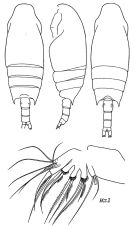 issued from : E.L. Markhaseva in Proc. Zool. Inst. RAN, St. Petersburg, 1996, 268. [p.120, Fig.91]. Female.
|
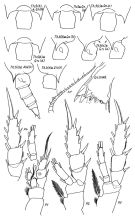 issued from : E.L. Markhaseva in Proc. Zool. Inst. RAN, St. Petersburg, 1996, 268. [p.121, Fig.92]. Female (from different localities). GntbMd: gnathobase of Md (partial)..
|
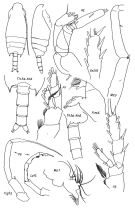 issued from : E.L. Markhaseva in Proc. Zool. Inst. RAN, St. Petersburg, 1996, 268. [p.122, Fig.93]. Male (from Kuril Trench). Re: exopod; P.md: mandibular palp; Abd: urosome.
|
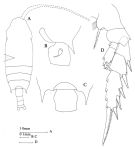 issued from : J.M. Bradford & J.B. Jillett in Mem. N.Z. Oceanogr. Inst., 86, 1980. [p.25, Fig.13]. Female: A, habitus (dorsal); B, posterior metasome and genital segment (lateral left side); C, idem (dorsal); D, P2. Nota: The setation of the mouth parts is identical with that of C. poppei.
|
 issued from : O. Tanaka in Publ. Seto Mar. Biol. Lab., 1957, VI (1). [p.55, Fig.34]. As Chiridius carnosus. Male: a, habitus (dorsal); b, forehead (lateral); c, last thoracic segment and urosome (lateral left side); d, P1; e, P2; f, P5. Nota: Head and 1st thoracic segment fused, 4th and 5th incompletely fused. Proportional lengths of urosomites and furca 18:22:25:18:2:15 = 100. A1 (23-segmented) reaches back to distal end of 2nd urosomal segment. Right A1 with segments 20 and 21 fused with long aesthetasks. Mx1: 9 setae on endopod, 5 setae on 1st outer lobe, 9 setae on exopod.
|
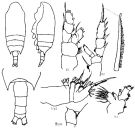 Issued from : K.A. Brodskii in Calanoida of the Far Eastern Seas and Polar Basin of the USSR. Opred. Fauna SSSR, 1950, 35 (Israel Program for Scientific Translations, Jerusalem, 1967) [p.154, Fig.68]. Female (from S Okhotsk Sea): habitus (dorsal and lateral left side); last thoracic segment and urosome (dorsal); corner of the last thoracic segment and genital segment (lateral left side); Mx, Mx1; Mp1, Mx2; S1, P1; S2, P2. Nota: A characteristic feature of the new species are the form of the thoracic spikes, which are large, slightly converging apically, and the relatively wide segments of P1.
|
 Chiridius pacificus Chiridius pacificus female: 1 - Exopod of Mx1 with 10 setae. Points of last thoracic segment reaching to the end of first third of genital segment. 2 - Endopodal segment 2 of Md wuith 8 (7 terminal and 1 posterior) setae. 3 - Points of last thoracic segment exceeding the middle of genital segment. Exopodal segment 3 of P1 with external spine 1.30-1.47 longer than external spine of segment 2.
|
 Chiridius pacificus Chiridius pacificus male: 1 - Points of last thoracic segment exceeding the posterior border of genital segment.
| | | | | Ref. compl.: | | | Hattori, 1991 (tab.1, Appendix); Heinrich, 1992 (p.86); 1992 a (p.749); 1995 (p.384: Rem., tab.1); Ikeda & al., 2006 (p.1791, Table 2); Galbraith, 2009 (pers. comm.) | | | | NZ: | 5 | | |
|
Carte de distribution de Chiridius pacificus par zones géographiques
|
| | | | | | 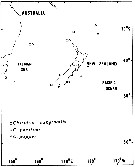 Issued from : J.M. Bradford & J.B. Jillett in New Zealand Ocean. Inst. Memoir, 86, 1980. [p.90-91, Fig.71]. Issued from : J.M. Bradford & J.B. Jillett in New Zealand Ocean. Inst. Memoir, 86, 1980. [p.90-91, Fig.71].
Distribution of several species of Chiridius in the Tasman Sea and around New Zealand.
Nota: Chiridius subgracilis ( = Chiridius molestus). |
| | | | Loc: | | | Okhotsk Sea, Kuril-Kamchatka, Kamchatka Trench, Vancouver Is., Japan (Sagami, off Sanriku, NE), New Zealand, off S Madagascar.
Type locality: Sea of Okhotsk (southern part) | | | | N: | 10 | | | | Lg.: | | | (22) F: 3-2,08; (37) F: 3,5-2,7; M: 2,65-2,36; (39) M: 2,36; (201) F: 3,5-2,7; {F: 2,08-3,50; M: 2,36-2,65} | | | | Rem.: | méso-bathypélagique, hyperbenthique. | | | Dernière mise à jour : 01/01/2015 | |
|
|
 Toute utilisation de ce site pour une publication sera mentionnée avec la référence suivante : Toute utilisation de ce site pour une publication sera mentionnée avec la référence suivante :
Razouls C., Desreumaux N., Kouwenberg J. et de Bovée F., 2005-2025. - Biodiversité des Copépodes planctoniques marins (morphologie, répartition géographique et données biologiques). Sorbonne Université, CNRS. Disponible sur http://copepodes.obs-banyuls.fr [Accédé le 05 janvier 2026] © copyright 2005-2025 Sorbonne Université, CNRS
|
|
 |
 |










